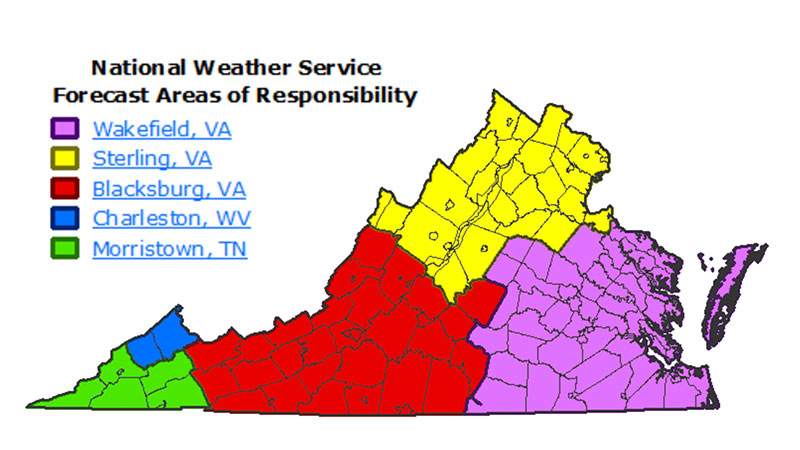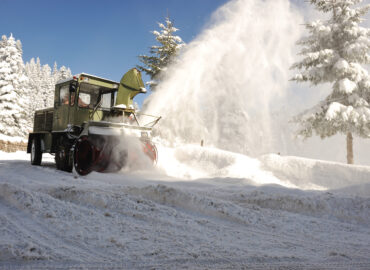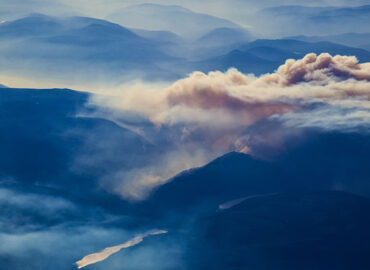If there’s one thing you should know about the topography of Virginia, it’s this: It’s not flat. Not entirely flat, at least. Elevation in the state varies, and its topography is diverse.
You can be at sea level in Tidewater or you could be standing nearly 6,000 feet above sea level from the top of Mount Rogers’ peak in Grayson County. While the eastern part of the state is relatively flat, its western region features mountains and ridges.
It’s important to talk about topography when discussing weather and climate because these physical features affect an area’s temperature, precipitation, and air movement. For instance, if a region has a mountain, it acts as a barrier that influences wind and rainfall in the locality.
Virginia is divided into five geographical regions: Coastal Plain (Tidewater), Piedmont, Blue Ridge Mountains, Valley and Ridge, and Appalachian Plateau. In general, the Old Dominion has a temperate climate with moderate rainfall. While the spring and fall seasons are extended, Virginians enjoy all four seasons in the year. But, let’s see how the topography of these areas influences the weather and climate in the state.
The Coastal Plain aka Tidewater Region
The Coastal Plain, also known as Tidewater, is a low-lying region that extends westward from the Atlantic Ocean to the area called Fall Zone (more on this below). The Coastal Plain is characterized by mostly low, flat land, crossed by broad, slowly moving streams and rivers.
Winters here are mild. On the other hand, summer time in the region can get “sticky” and temperatures are 5 degrees warmer than Piedmont. That is, summer here is warm and humid, with occasional hurricanes. These are the results of the abundance of water along the East Coast, particularly the Atlantic Ocean and the Chesapeake Bay. There are also many rivers and their tributaries in the area, which also affect the climate of the Coastal Plain.
Fall Zone aka Fall Line
The Fall Zone, also called Fall Line, is a narrow region where streams cascade from Piedmont to the Coastal Plain. Running through the port cities of Petersburg, Alexandria, Richmond, and Fredericksburg, it acts as the natural border between Piedmont and the sTidewater region.
Similar to the Coastal Plain region, the Fall Zone also experiences hot and humid summers and mild winters.
Piedmont
A French word which means “foot of the mountains,” Piedmont is just that. Extending from Pennsylvania to Alabama, it is the largest region in Virginia. It is located west of the Fall Line and east of the Blue Ridge Mountains.
From the Coastal Plain, Piedmont starts out as a rolling hill country. As it moves westward, it forms the foothills of the Blue Ridge Mountain, rising to 1,000 feet and doubling in height. Here, the topography becomes more rugged. Piedmont’s bedrock is part of the ancient Appalachian mountain belt. The region contains many rivers and streams as well as forests, meadows, and farmlands.
The area features more temperature fluctuations than Virginia’s coastal areas. Summers here are hot and winters are cool, with the chance of occasional frost.
Blue Ridge Mountains
So called because they look blue from a distance, the Blue Ridge Mountains runs from Southern Pennsylvania to the northern tip of South Carolina. The mountain range rises to more than 4,000 feet in the central and northern parts of the state and includes Virginia’s highest peak, Mount Rogers, at 5,729 feet.
The climate here varies according to elevation. In general, lower elevations feature a humid subtropical climate, while higher elevations have a more temperate climate. Precipitation is fairly consistent year-round, while its moderate to high humidity creates misty conditions.
Its thick forest covering becomes laden with snow during the winter, which produces cold temperatures, especially in the northern part of the mountain range. The frosty winter temperature has been described as like that of Chicago.
In the summertime, the region features less humidity and cooler air than the Coastal Plain. It is 10 degrees cooler here, on average, in any season compared to the other climate zones of Virginia. Moreover, west of the Blue Ridge Mountains, the minimum temperature is 5 degrees cooler than the east side of the mountains.
Valley & Ridge
Virginia’s Valley and Ridge region is the biggest part (bigger than that of any other state) of the Great Valley, a huge trough that runs from Quebec to Alabama. This region also features hills, narrow and long ridges that are 3,000 to 4,000 feet high as well as flat, lush valleys, hot springs, caves, and caverns.
Summers here are pleasantly warm, while winters are not too cold. The valleys are generally warmer than the surrounding mountains. The northern part of this region experiences a humid continental climate, while the southern part has a humid subtropical climate.
Appalachian Plateau
Located in the southwestern part of the state, the Appalachian Plateau is the smallest of Virginia’s climate zones. It extends from New York to Alabama and contains only three counties (Buchanan, Wise, and Dickenson).
The hilly and rugged terrain features many valleys and some flat land. The plateau is covered with forests and is rich in natural resources, such as coal, natural gas, and petroleum.
The region experiences a temperate, wet climate with hot, humid summers and cool, wet winters.
3 Topographical Features That Influence Virginia’s Climate
In addition to the five climate zones mentioned above, there are three local controls that significantly affect the state’s climate.
The Atlantic Ocean and the Gulf Stream
These two bodies of water have a major impact on Virginia’s precipitation, especially during the cold season. In particular, winter storms in the state have a west to east trajectory, in general. When it reaches the coast, the storm follows the warm waters of the Gulf Stream in a northeastward movement parallel to the coast.
Rain Shadow Effect in the Appalachian and Blue Ridge Mountain Systems
These mountain systems play a huge part in Virginia’s rainfall pattern. Basically, more rain falls on one side of the mountain and little rain on the other side. As a result, one side of the mountain is well watered while the other side is dry. This natural phenomenon is known as the rain shadow effect.
In particular, moist air from the Pacific Ocean moves eastward and falls on the western slopes of the Appalachian Mountains. The New River and Shenandoah River valleys are in the rain shadow as a result. When moisture comes from the Atlantic Ocean and airflow is from the east to the west, the New River and Shenandoah River valleys receive low rainfall and are thus the driest portions of the state.
Virginia’s Rivers and Streams
The Commonwealth has a complex pattern of rivers and streams. They drain Virginia’s terrain in all four directions. Moreover, these rivers and streams also modify the moist airflow pattern.





